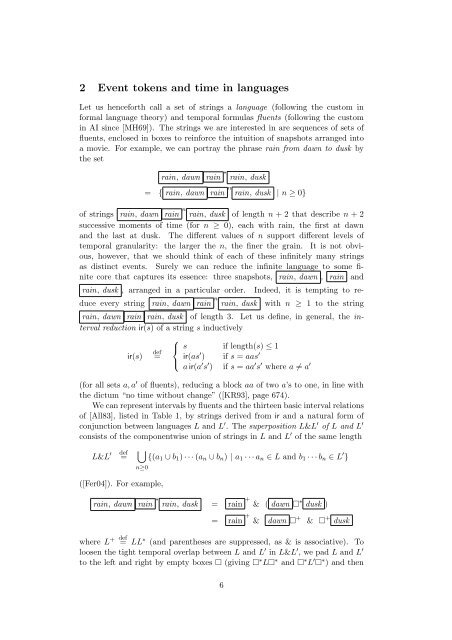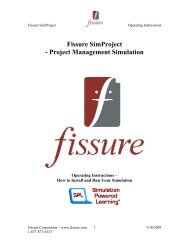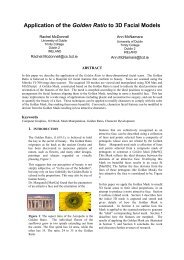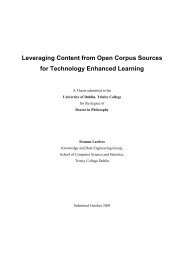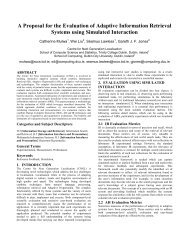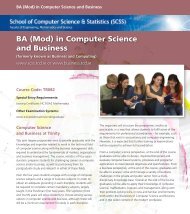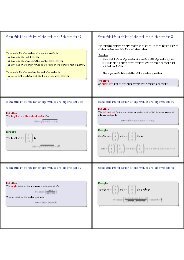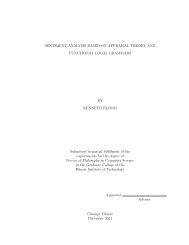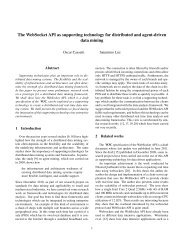Situations from events to proofs 1 Introduction
Situations from events to proofs 1 Introduction
Situations from events to proofs 1 Introduction
Create successful ePaper yourself
Turn your PDF publications into a flip-book with our unique Google optimized e-Paper software.
2 Event <strong>to</strong>kens and time in languages<br />
Let us henceforth call a set of strings a language (following the cus<strong>to</strong>m in<br />
formal language theory) and temporal formulas fluents (following the cus<strong>to</strong>m<br />
in AI since [MH69]). The strings we are interested in are sequences of sets of<br />
fluents, enclosed in boxes <strong>to</strong> reinforce the intuition of snapshots arranged in<strong>to</strong><br />
a movie. For example, we can portray the phrase rain <strong>from</strong> dawn <strong>to</strong> dusk by<br />
the set<br />
rain, dawn rain ∗ rain, dusk<br />
= { rain, dawn rain n rain, dusk | n ≥ 0}<br />
of strings rain, dawn rain n rain, dusk of length n + 2 that describe n + 2<br />
successive moments of time (for n ≥ 0), each with rain, the first at dawn<br />
and the last at dusk. The different values of n support different levels of<br />
temporal granularity: the larger the n, the finer the grain. It is not obvious,<br />
however, that we should think of each of these infinitely many strings<br />
as distinct <strong>events</strong>. Surely we can reduce the infinite language <strong>to</strong> some finite<br />
core that captures its essence: three snapshots, rain, dawn , rain and<br />
rain, dusk , arranged in a particular order.<br />
Indeed, it is tempting <strong>to</strong> reduce<br />
every string rain, dawn rain n rain, dusk with n ≥ 1 <strong>to</strong> the string<br />
rain, dawn rain rain, dusk of length 3. Let us define, in general, the interval<br />
reduction ir(s) of a string s inductively<br />
⎧<br />
⎨<br />
ir(s)<br />
def<br />
=<br />
⎩<br />
s if length(s) ≤ 1<br />
ir(as ′ ) if s = aas ′<br />
a ir(a ′ s ′ ) if s = aa ′ s ′ where a ≠ a ′<br />
(for all sets a, a ′ of fluents), reducing a block aa of two a’s <strong>to</strong> one, in line with<br />
the dictum “no time without change” ([KR93], page 674).<br />
We can represent intervals by fluents and the thirteen basic interval relations<br />
of [All83], listed in Table 1, by strings derived <strong>from</strong> ir and a natural form of<br />
conjunction between languages L and L ′ . The superposition L&L ′ of L and L ′<br />
consists of the componentwise union of strings in L and L ′ of the same length<br />
L&L ′<br />
def<br />
= ⋃ n≥0{(a 1 ∪ b 1 ) · · · (a n ∪ b n ) | a 1 · · · a n ∈ L and b 1 · · · b n ∈ L ′ }<br />
([Fer04]). For example,<br />
rain, dawn rain ∗ rain, dusk = rain + & ( dawn □ ∗ dusk )<br />
= rain + & dawn □ + & □ + dusk<br />
where L + def = LL ∗ (and parentheses are suppressed, as & is associative). To<br />
loosen the tight temporal overlap between L and L ′ in L&L ′ , we pad L and L ′<br />
<strong>to</strong> the left and right by empty boxes □ (giving □ ∗ L□ ∗ and □ ∗ L ′ □ ∗ ) and then<br />
6


